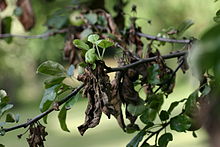Destructive disease caused by the bacterium Erwinia amylovora that occurs in plants in the pome family; symptoms include a blackening of shoots. as though burned
Fire blight, also written fireblight, is a contagious disease affecting apples, pears, and some other members of the family Rosaceae. It is a serious concern to apple and pear producers. Under optimal conditions, it can destroy an entire orchard in a single growing season.
| Fire blight | |
|---|---|

| |
| Scientific classification | |
| Domain: | Bacteria |
| Phylum: | Pseudomonadota |
| Class: | Gammaproteobacteria |
| Order: | Enterobacterales |
| Family: | Erwiniaceae |
| Genus: | Erwinia |
| Species: | E. amylovora
|
| Binomial name | |
| Erwinia amylovora (Burrill 1882) Winslow et al. 1920
Type strain = NCPPB 683 | |
The causal pathogen is Erwinia amylovora, a Gram-negative bacterium in the genus Erwinia, order Enterobacterales. It is a short rod with rounded ends and many peritrichous flagellae. Pears are the most susceptible, but apples, loquat, crabapples, quinces, hawthorn, cotoneaster, Pyracantha, raspberry and some other rosaceous plants are also vulnerable. The disease is believed to be indigenous to North America, from where it spread to most of the rest of the world.
Fire blight is not believed to be present in Australia though it might possibly exist there. It has been a major reason for a long-standing embargo on the importation of New Zealand apples to Australia. In Europe it is listed as a quarantine disease, and has been spreading along Hawthorn (Crataegus) hedges planted alongside railways, motorways and main roads.
